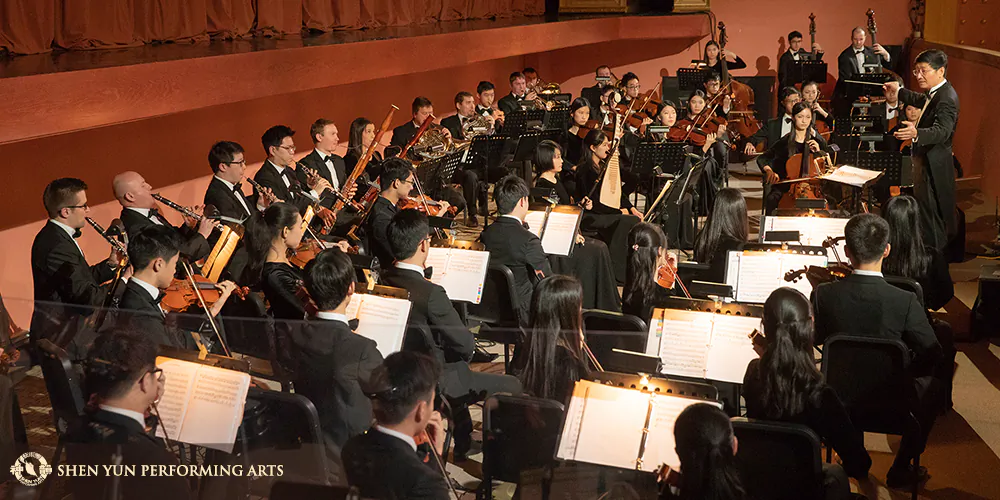The Shen Yun Symphony Orchestra (SYSO) is hard at work, rehearsing for its upcoming concert at Lincoln Center—the first in three years.
On Oct. 22, SYSO will take to the stage at David Geffen Hall in New York City at 1 p.m. and 5 p.m. for one day of concerts only.
SYSO is a unique ensemble, drawing from the best musicians among the eight touring groups of Shen Yun Performing Arts. This symphony blends ancient Chinese instruments with violins, clarinets, and other Western instruments, like the orchestras accompanying Shen Yun’s touring productions.
Listeners often say they feel transported to ancient China and the heavenly realms of its stories.
“The music is so evocative. It really transports you to a different time and place,” said Mimi Martinoski, an author, after attending a past performance. “You can feel it in your heart, in your soul.”
Each concert features a handful of classical favorites. Still, the highlight of the SYSO performance is undoubtedly the original works, which make full use of the Chinese instruments in the ensemble and tell the story of 5,000 years of civilization.
For countless generations prior to the rise of communism in China, the Chinese people held the belief that their culture was of divine inspiration, adhering to the central principle of seeking harmony among Heaven, Earth, and humanity. It was only with the ascent of the atheist regime to power that China’s traditional culture began to erode.
Many of SYSO’s repertoire often comprises compositions initially created for New York-based Shen Yun Performing Arts’ annual tours. These performances encompass a wide range of dances, each representing different dynasties as well as the four corners of what was once called the Celestial Empire. Shen Yun’s composers have skillfully portrayed various subjects in their music, including Manchurian princesses, Tang dynasty poets, and legendary emperors.
Music From the Golden Age
Since its establishment in 2006, Shen Yun has frequently showcased scenes from the Tang Dynasty (618–907), often called the Golden Age of Chinese civilization. This era was marked by significant advancements in various forms of art. Emperor Xuangzong, a skilled musician, established and oversaw an imperial music academy to nurture and cultivate talented musicians.
During a previous season, Shen Yun introduced the composition “Homage to the Great Tang Dynasty,” a piece characterized by swift thematic changes mirroring the rapid progress of this innovative dynasty. The music transitions from an intense opening to stately melodies that symbolize the era of peace and prosperity that ensued.
In a Shen Yun interview, the composer said that encapsulating the grandeur of three centuries within the Tang Dynasty in a mere 9-minute piece was no small feat.
After the ascent of Emperor Tang Taizong, renowned for elevating Chinese civilization to new heights, the gong was used to bring the audience into the imperial palace. Various exotic melodies represent the numerous foreign dignitaries who journeyed to China during this period. At the time, the Tang Dynasty was the dominant empire in Asia, with its capital being the most cosmopolitan city in the world.
This great cultural exchange also influenced the music, which gained influence from Persia, Arabia, and Dunhuang, a major outpost on the Silk Road.
“Shen Yun musicians find it enlightening to perform uniquely different compositions such as Great Tang, because they provide a window to experiencing the surprising differences between China’s dynasties,” the company’s website notes.
From Mongolia to Tibet
China has remained diverse throughout its 5,000 years and is still home to some 50-plus ethnic minorities.
In a past season, the performing arts company premiered a piece titled “The Great Khan,” telling the story of the founding emperor of the Yuan Dynasty and the Mongolian Empire. Kublai Khan (1215–1294) was the son of the infamous Genghis Khan and the first non-Han emperor of a unified China.
The piece opens with the brass and percussion signaling the entrance of Mongolian warriors, with the music quickly developing to depict a battlefield.
Another frequent favorite is the oft-included Tibetan dances, which portray the rhythmic movements of those residing in the high and snowy regions of the Himalayas. The accompanying music aptly captures the bouncing, side-to-side rhythm, reminiscent of the winding mountain roads traversed daily by the Tibetan people.
A SYSO program is as diverse as the Shen Yun dance programs, and audience members say every year that it transports them to another land and time.
“There were moments I felt that they were flying to the clouds and to the gods at some points, especially with the pizzicato on the string instruments, down looking on horses, on chariots, headed up to the skies,” said Arthur Comegno, a musician and conductor, at the Boston Symphony Hall after a performance in 2019.
“And then there’s a lot of love and passion in the music,” he said. “I’m seeing it connected to the universe, to love, to the spirit.
“The best thing I can say was it was a fantastic concert, and I was amazed and overwhelmed,” he said. “I hope to come back and listen to it again.”
Additional encore performances can be found on GanJingWorld.com and ShenYunCreations.com.
Tickets are now on sale at ShenYunSymphony.org.
From The Epoch Times
